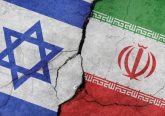Despite the appalling course of events since 7 October, the continuing fighting and the suffering of the bereaved and displaced in Israel and Gaza, people are beginning to ask where this will all end, how it will end, and even whether it will end?
It is essential to address these questions now, because a lasting solution can only be found once people on both sides have some hope for the future
The emergence of the two-state solution
Since the 1917 Balfour Declaration declared support for a Jewish homeland in Palestine and fuelled the two growing national movements of Jews and the Palestinian Arabs, there have been only three possible solutions to the question of who lives in the land between the river Jordan and the Dead Sea to the east and the Mediterranean to the west; and two of them are not real solutions at all.
One is that all the Palestinian people leave the region and find somewhere else to live, leaving it as an exclusively Jewish state.
A second is that the clock is turned back to the time before Israel existed, the Jewish people leave again and the Palestinians re-occupy the land.
The third is to find a way for the two peoples to live together in peace, freedom, and respect in this area.
Each of the first two options is supported by some on one side or the other: the first is the implicit aim of some of the Jewish settlers and their political leaders, who are forcing Palestinians from their land in the West Bank; the second is the explicit aim of Hamas, which demonstrated its murderous determination on 7 October. But each would be so unacceptable to the majority – if not all – on the other side that such solutions would lead not to security for anyone but to perpetual conflict, with each side living in constant fear of the other. Moreover, neither of the first two solutions can be achieved by force of arms without the death toll continuing to rise into the indefinite future, and the conflict most likely spreading across the region.
This leaves the third solution as the only way forward. After the partition of 1948 and the wars that followed, the 1993 Oslo Accords, which proposed a two-state solution, became the version of this solution preferred by the leaders on both sides – at least for a while. It was endorsed by the Arab Peace Initiative in 2002, which would also have resolved the wider conflict between Israel and its Arab neighbours, and formed the basis of the EU-US-UN-Russia ‘Road Map for Peace’ in 2003.
But it has not been delivered. Instead, we have leaders on both sides – in Hamas and in the current Israeli government – who seem to believe that force is the only way to a solution.
There are reasons for this. Many liberation movements have struggled to transform into pluralistic, transparent political systems. Fatah’s installation as the Palestinian Authority and its failure to maintain a popular mandate through elections, through achieving economic growth, or by engaging with the growing population of young Palestinians, on top of its security cooperation with Israel, has undermined its political legitimacy and effectiveness. Hence the rise of Hamas, seen as actually doing something to fight for Palestinian rights.
On the Israeli side, the implementation of Oslo was set back first by the assassination of Yitzak Rabin and then by a slowdown in the negotiations, which finally stopped in 2014. Over the past decade, the Israeli government of Benjamin Netanyahu has systematically obstructed the process and enabled the growth of Israeli settlements in the West Bank, particularly under the current coalition with far right nationalist parties. Combined with security and travel controls, these actions have made the realisation of a viable Palestinian state unattainable.
Nevertheless, since 7 October the international community, from the UN, the US and the EU to the Arab-Islamic Conference on 11 November, has lined up to reaffirm its commitment to a two-state solution as the only path to peace between Israelis and Palestinians.
But is a two-state solution still viable?
In practice, it would require a change of leadership on both sides. Netanyahu’s policies got the Israelis into this mess and he is not the man to get them out of it. Since the crisis erupted on 7 October, he has given no indication of a willingness to resume negotiations, but has focused exclusively on crushing Hamas in Gaza, arresting suspected Hamas activists in the West Bank, and turning a blind eye to settler violence against Palestinian communities there. This risks strengthening Hamas’s political legitimacy among young Palestinians, even as it weakens its military capabilities. The penny has yet to drop that the only way to defeat Hamas is politically, not militarily. And that will require a government in Israel, elected by its people, that is willing and able to contain the ambitions of Jewish settlers in the West Bank and implement a ‘land for peace’ deal.
At least the Israelis can change their government through elections if they choose. The last Palestinian presidential election was held in 2005, with President Abbas now in the 18th year of a four-year term, while Hamas’s control of politics in Gaza since 2007 scarcely qualifies as free and fair. How to renew the Palestinian leadership is a major challenge. Who to talk to? How can they be chosen? As Abbas himself knows, putting the Palestinian Authority in charge of Gaza would only work in the context of a much broader political settlement. Any leadership must have credibility with the Palestinians themselves if it is to play an effective role in negotiations.
The big risk inherent in the two-state solution is illustrated by what has happened already: that in two states living next to each other in mutual fear, politics will always tend towards polarisation. Politicians in each state will outdo each other in trying to be the stronger defender of their community against the threat from their neighbours. There are insufficient political incentives for moderation.
In fact, Fatah lost ground to Hamas among Palestinians precisely because it was willing to cooperate with Israel while Hamas maintained an uncompromising stance. At the same time, we have seen a relentless shift to the right in Israeli politics, as Likud has become the dominant political force, able to stay in power since the 2022 election only in coalition with even more extreme right wing parties. The left, and those who supported the peace process, have effectively been marginalised or have disappeared altogether.
Is there any alternative to a two-state solution?
The reality is that there is already a de-facto unitary state, but an unequal one. Israel has shown its determination to eliminate any effective security force other than its own throughout the territory it occupies and in Gaza, for reasons graphically illustrated on 7 October. But if completely driving the Palestinians from this space is both internationally unacceptable and a recipe for perpetual conflict, the only alternative is to accept them as equal participants in the single state that exists, give them a stake in its success, and create those incentives for moderation that would reduce the risk of ever more extreme nationalism on both sides. Before the present crisis, Palestinian public opinion was already moving against a two-state solution, with a growing number favouring a single state with equal rights.
The immediate objection to a single state with equal rights would be that it would de-nature what was created to be a Jewish state, the only state where many Jews felt their safety could be guaranteed in a hostile world. But are they safe now? Has the marginalisation and containment of the Palestinian population actually led to their effective security?
Experience elsewhere suggests that it is not beyond the human intellectual capacity to find a constitutional structure that allows two communities to live peacefully and equally in the same space in a way that each of them feels secure. There are two examples of (relatively) successful peace processes in similar circumstances: South Africa and Northern Ireland. They demonstrate that warring communities can be reconciled. Of course, politics does not stop. Both countries face their own difficulties, tensions remain, and disagreements continue, but for now they can be settled peacefully, rather than at the barrel of a gun.
Each situation is profoundly different. There is no existing model for Israelis and Palestinians to follow: only they can find their own way to peace. Starting from where we are, the journey will be very long. But whether it ends in two states or one, it is already clear that the only alternative paths lead not to peace or security, but to perpetual war.
Note: This article reflects the views of the author and not the position of the DPIR or the University of Oxford.






